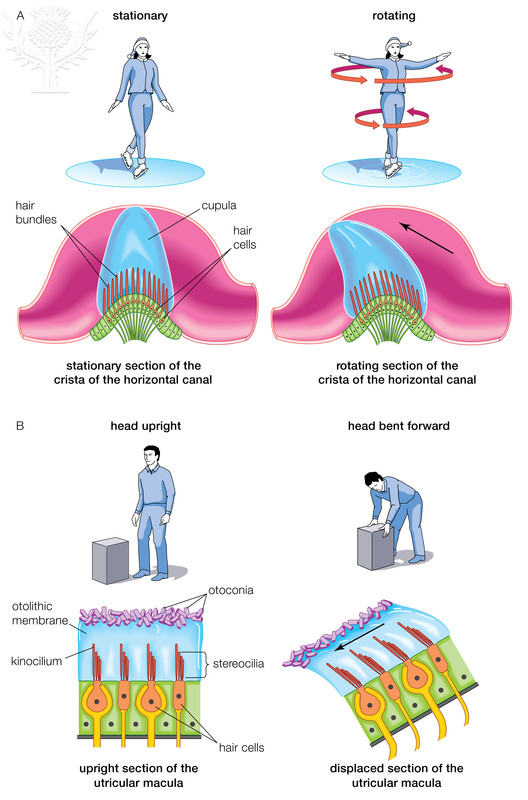SPECIAL SENSES
THE SENSE OF BALANCE AND EQUILIBRIUM

Title: File:Blausen 0329 EarAnatomy InternalEar.png; Author: Blausen.com staff. "Blausen gallery 2014". Wikiversity Journal of Medicine. DOI:10.15347/wjm/2014.010. ISSN 20018762.; Site: https://commons.wikimedia.org/wiki/File:Blausen_0329_EarAnatomy_InternalEar.png; License: This file is licensed under the Creative Commons Attribution 3.0 Unported license.
The senses of equilibrium and balance is very similar to that of hearing in that it involves the use of hair cells and fluid movements. The function of the hair cells involved with equilibrium and balance is the same as that involved with hearing, the difference is in how the stereocilia get bent. Instead of the cochlea, the hair cells of equilibrium are located in two structures: the vestibular apparatus and the semicircular canals. The vestibular apparatus is designed to sense linear movement as well as the position of our head in relation to gravity. It is sometimes referred to as the static labyrinth. The semicircular canals are designed to detect angular movement and are referred to as the kinetic labyrinth.
The sensory organs in the vestibular apparatus are the otolith organs. Within these organs is a specialized sensory structure called the macula. It consists of a sheet of hair cells whose stereocilia are imbedded in a gelatinous mass (see the image below). Within this mass are protein and calcium carbonate crystals known as otoliths (ear rocks) that provide weight to the gelatinous mass. It is designed so that when we tilt our heads this mass slides, bending the hair cells. Likewise when we accelerate linearly, due to the inertia of the mass it lags behind the movement of the head, again bending the hair cells. When we stop, the mass continues to move due to inertia, bending the hair cells in the opposite direction. Each ear has two otolith organs, one oriented horizontally, the utricle, and one oriented vertically, the saccule. The saccule is responsible for that feeling you love when the elevator starts and stops moving.
The sensory organs of the semicircular canals are designed to detect angular movement. In each ear there are three semicircular canals oriented at right angles to each other. Think of them as being in the frontal, sagittal, and horizontal planes. These canals attach to the vestibular apparatus and are designed so that fluid will flow within the canal. Therefore, if you shake your head side-to-side as if you were saying “no” the fluids in the horizontal canals will move. When you nod you head up and down like when you say “yes”, fluid in the sagittal canal will move. And when you move your head back and forth from shoulder to shoulder fluid in the frontal canal will move. At the base of each canal where it attaches to the vestibular apparatus is an enlargement called the ampulla. Within the ampulla is the sensory apparatus, the crista. The crista contains hair cells that are embedded in a gelatinous mass called the cupula. The cupula extends from the hair cells to the top of the ampulla, acting somewhat like a small sail. When the fluid moves through the semicircular canals it pushes the cupula over, which causes the stereocilia on the hair cells to bend (see the image below). Because we have canals oriented in all three planes, any angular movement can be detected. The combination of input from the vestibular apparatus and the semicircular canals informs us about our orientation with respect to gravity as well as any linear or angular movement of our body. Sickness or damage to these organs results in dizziness and even the inability to maintain balance.

© 2013 Encyclopædia Britannica, Inc. Downloaded from Image Quest Britannica; BYU-Idaho.
**You may use the buttons below to go to the next or previous reading in this Module**

